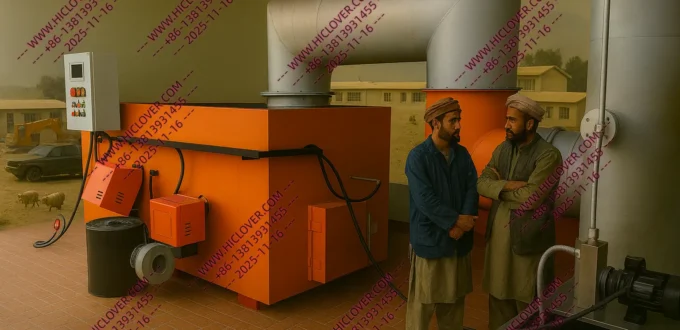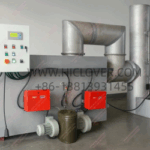Strengthening Medical Waste Management in Afghanistan: The Role of Modern Incinerators under International Aid Programs
Background: International Support and Local Challenges
Afghanistan continues to face significant challenges in healthcare waste management despite increased attention from international institutions such as the United Nations (UN), UNICEF, World Bank, and World Health Organization (WHO). Over the past decade, these organizations have launched various programs to improve healthcare infrastructure, immunization coverage, and infection control across provinces like Kandahar, Nangarhar, Herat, Balkh, and Paktya.
However, the rapid expansion of healthcare activities, especially through National Expanded Program on Immunization (NEPI), has also generated a growing volume of infectious medical waste — including syringes, vaccine vials, and contaminated materials. In many rural and semi-urban areas, the absence of reliable waste treatment equipment has led to unsafe practices such as open burning and pit burial, posing serious environmental and health risks.
Current Situation: Limited Infrastructure and Unsafe Disposal
Most Afghan healthcare facilities, particularly in provincial districts, still lack standardized medical waste incineration systems. Waste is often mixed with general garbage and transported without segregation. Open burning in uncontrolled conditions leads to the release of toxic smoke and pathogens, directly affecting local communities and medical personnel.
Additionally, due to limited funding and maintenance capacity, many older incinerators remain non-operational or fail to meet international emission standards. Hospitals in cities like Kabul and Mazar-i-Sharif may have partial equipment, but rural clinics largely depend on improvised waste pits or manual disposal.
The Need for Safe and Scalable Incineration Technology
To meet WHO and UNEP guidelines, Afghanistan’s future healthcare waste strategy emphasizes high-temperature, dual-chamber incinerators capable of complete combustion and minimal smoke output. Technologies like the HICLOVER TS50 PLC medical waste incinerator have proven suitable for such environments due to their portable design, diesel or gas operation, and low maintenance requirements.
These systems can process 50 kg of waste per hour, ideal for regional hospitals and vaccination centers. Their containerized or modular structure allows rapid installation, even in remote provinces with limited infrastructure. In regions with difficult logistics — such as Paktya’s mountainous zones or Kandahar’s arid plains — mobile or skid-mounted incinerators are particularly effective.
Integration with National and International Initiatives
Recent UNDP and UNICEF procurement frameworks aim to install standardized medical waste treatment units across five key regions. These incineration systems are expected to:
-
Replace unsafe open burning and burial.
-
Ensure emissions compliance with WHO guidelines and GB 18484-2020 standards.
-
Provide safer working environments for healthcare workers.
-
Enable sustainable operation through training and local capacity building.
Projects supported by USAID and World Bank’s Health Emergency Response Program are also prioritizing equipment that reduces maintenance complexity and supports renewable energy integration in the future.
Environmental and Social Benefits
Modern incineration systems contribute directly to Afghanistan’s broader environmental health goals. By reducing the uncontrolled release of pollutants, they protect groundwater, air quality, and community health. Furthermore, properly managed ash disposal prevents soil contamination — a vital factor for agricultural zones near Jalalabad and Herat.
On a social level, reliable waste treatment enhances public confidence in healthcare systems, particularly during nationwide immunization campaigns and pandemic responses.
Future Outlook
Afghanistan’s healthcare waste management roadmap envisions a hybrid system combining incineration, segregation, and safe transport. With continued international aid and local technical cooperation, the next five years could witness:
-
Nationwide deployment of containerized medical waste incinerators.
-
Establishment of regional maintenance and training hubs.
-
Gradual integration of energy recovery and emission filtration systems.
For manufacturers and suppliers like HICLOVER (www.hiclover.com), this represents both a humanitarian opportunity and a sustainable partnership model to support Afghanistan’s rebuilding process through reliable waste treatment technology.
Localized Insight
In Afghan healthcare practice, reliability and ease of use are essential. “Simple equipment that works in any condition is more valuable than complex systems that fail without spare parts.” As the country rebuilds, such practical technologies will define the success of medical waste treatment modernization.
Brief Summary in Pashto and Dari
پښتو:
په افغانستان کې د طبي کثافاتو د مدیریت لپاره د نوو سوځونکو ماشینونو کارول د روغتیا د خوندیتوب او چاپېریال د ساتنې لپاره خورا مهم دي. د نړیوالو ادارو ملاتړ د دې سبب شوی چې د روغتیایي مرکزونو لپاره د معیاري وسایلو نصب پیل شي.
دری:
در افغانستان، استفاده از دستگاههای سوزانندهٔ زبالههای طبی گام مهمی در جهت بهبود بهداشت و محیط زیست است. با کمک سازمانهای بینالمللی، پروژههای نصب تجهیزات جدید در شفاخانهها در حال اجرا میباشد.
2025-11-16/10:33:48
|
Incinerator Items/Model |
HICLOVER TS100(PLC)
|
|
Burn Rate (Average) |
100kg/hour |
|
Feed Capacity(Average) |
150kg/feeding |
|
Control Mode |
PLC Automatic |
|
Intelligent Sensor |
Continuously Feeding with Worker Protection |
|
High Temperature Retention(HTR) |
Yes (Adjustable) |
|
Intelligent Save Fuel Function |
Yes |
|
Primary Combustion Chamber |
1200Liters(1.2m3) |
|
Internal Dimensions |
120x100x100cm |
|
Secondary Chamber |
600L |
|
Smoke Filter Chamber |
Yes |
|
Feed Mode |
Manual |
|
Burner Type |
Italy Brand |
|
Temperature Monitor |
Yes |
|
Temperature Thermometer |
Corundum Probe Tube, 1400℃Rate. |
|
Temperature Protection |
Yes |
|
Automatic Cooling |
Yes |
|
Automatic False Alarm |
Yes |
|
Automatic Protection Operator(APO) |
Yes |
|
Time Setting |
Yes |
|
Progress Display Bar |
3.7 in” LCD Screen |
|
Oil Tank |
200L |
|
Chimney Type |
Stainless Steel 304 |
|
1st. Chamber Temperature |
800℃–1000℃ |
|
2nd. Chamber Temperature |
1000℃-1300℃ |
|
Residency Time |
2.0 Sec. |
|
Gross Weight |
7000kg |
|
External Dimensions |
270x170x190cm(Incinerator Main Body) |
|
Burner operation |
Automatic On/Off |
|
Dry Scrubber |
Optional |
|
Wet Scrubber |
Optional |
|
Top Loading Door |
Optional |
|
Asbestos Mercury Material |
None |
|
Heat Heart Technology(HHT) |
Optional |
|
Dual Fuel Type(Oil&Gas) |
Optional |
|
Dual Control Mode(Manual/Automatic) |
Optional |
|
Temperature Record |
Optional |
|
Enhanced Temperature Thermometer |
Optional |
|
Incinerator Operator PPE Kits |
Optional |
|
Backup Spare Parts Kits |
Optional |
|
Mobile Type |
Optional:Containerized/Trailer/Sledge Optional |



